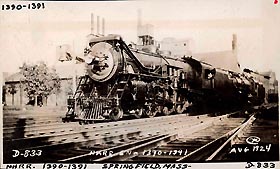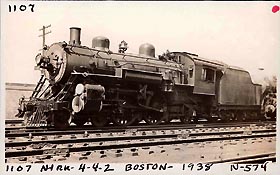|
This is an archived article.
For the latest news, go to the Advance
Homepage
For more archives, go to the Advance Archive/Search Page. |
||||
|
New
Haven Railroad Archives Go Digital
By Richard Veilleux
The New Haven Railroad was a force.
Now, for railroad buffs everywhere, the New Haven Railroad is again becoming a force. Archivists at the Thomas J. Dodd Research Center, after nearly two years of work, have catalogued, digitized, and created a website for the center's Railroad History Archive. The site includes nearly 500 photographs of steam and electric locomotives owned by the New Haven line that once steamed to dozens of cities and towns in southern New England. The digitized photos represent only about 10 percent of the meticulously documented pictures of New Haven Railroad equipment, primarily steam and electric locomotives, taken during the early to mid-1900s by Fred Otto Makowsky. The collection was donated to UConn by his nephew, Roy Makowsky, Class of '55. "Fred Makowsky was a railroad enthusiast of mammoth proportions," says Laura Smith, curator of the Dodd Center's business, railroad, and labor collections. And that enthusiasm, she says, led Makowsky to document his collection in a special way: "The Makowsky collection is a cohesive whole, documenting virtually every piece of steam and electric engine owned by the railroad," Smith notes. "He described each photograph, noting the type of locomotive, the date he shot the picture, background on the engine. It's quite impressive." For almost 100 years, the New York, New Haven, and Hartford Railroad, commonly called the New Haven Railroad (NHRR), was the primary means of passenger and freight transportation in southern New England. At its peak in 1929, the railroad owned and operated more than 2,000 miles of track in Connecticut, New York, Massachusetts, and Rhode Island. It was a pioneer in the electrification of railroads, sending the first electrified passenger train into New York in July 1907. The system began to decline after World War II, ultimately becoming part of the Penn Central system in 1969. When Penn Central faced financial troubles several years later, the system became ConnRail, Amtrak and, ultimately, MetroNorth. UConn has the largest collection of material extant on the New Haven Railroad, surpassing Harvard University's holdings. The collection includes more than 2,000 linear feet of documents and, now, thousands of photographs. With the new digital collection, it also will be one of the most accessible railroad collections in America. Each of the images was catalogued by the library's cataloguing team and is accessible through the library's online catalogue, Homer. When users come to the website, they are directed to "canned," or pre-determined searches. For fuller searching a user can go straight to Homer. The website - http://railroads.uconn.edu - points to the entire collection of photographs and documentation of the NHRR and its history, held in the Railroad History Archive. Material that can be accessed at the Dodd Center but is not posted online is listed, with identifying archival catalogue numbers for people who wish to visit the archive for further research. The complete collection includes administrative and payroll files, maps, blueprints, and other documents. In creating the website, Smith also called on the services of J.W. Swanberg of Branford, a noted railroad historian, who helped select a diverse pool of photographs for the online collection and assisted in describing each, to bring out the unique characteristic s of the locomotives and trains. Heidi Abbey, UConn's digital collections librarian, designed the site and helped digitize the collection. Staff in the University Center for Instructional Media and Technology scanned the photos. "The collection has always been used by a wide array of researchers," says Smith. "Genealogists, lawyers, land use professionals, environmentalists — there's no end to how the collection can be used. Even designers from Lionel trains, HO trains, and other model train enthusiasts use the site to perfect their reproductions." Swanberg, Roy Makowsky, and several other speakers will discuss the collection and the history of the NHRR during a 4 p.m. seminar Nov. 21 in the Dodd Center's Konover Auditorium. An exhibit of photographs from the Railroad History Archive will be shown in the Dodd Center Gallery in conjunction with the seminar. The exhibit will run from late October through Dec. 31. |
 ecades before I-95 was a daily nightmare, when legislators
spent little or no time discussing how to make commuting between
New York, Stamford, New Haven, New London and Boston easier, Iron
Giants traversed the countryside, connecting people from all parts
of Connecticut to the East Coast's major cities.
ecades before I-95 was a daily nightmare, when legislators
spent little or no time discussing how to make commuting between
New York, Stamford, New Haven, New London and Boston easier, Iron
Giants traversed the countryside, connecting people from all parts
of Connecticut to the East Coast's major cities.

